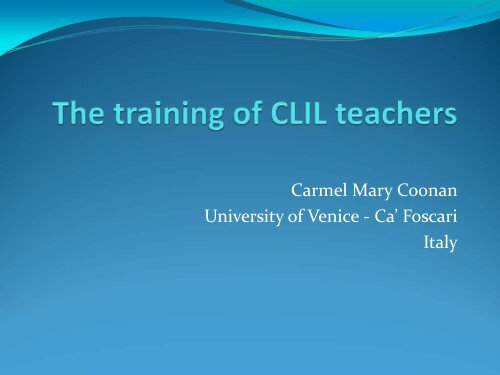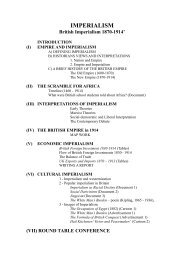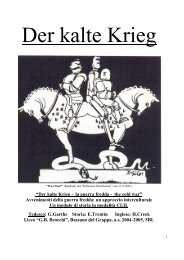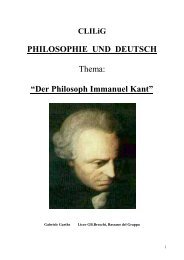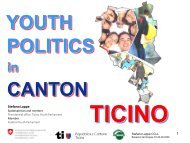read the PPT - CCLL: Common Constitution and Language Learning
read the PPT - CCLL: Common Constitution and Language Learning
read the PPT - CCLL: Common Constitution and Language Learning
Create successful ePaper yourself
Turn your PDF publications into a flip-book with our unique Google optimized e-Paper software.
Carmel Mary Coonan<br />
University of Venice ‐ Ca’ Foscari<br />
Italy
Aim of talk<br />
Situation as it is<br />
What is needed<br />
Focus on CLIL teacher competences
Definition of CLIL<br />
Eurydice, 2006<br />
The acronym CLIL is used as a generic term to describe<br />
alltypesofprovisioninwhichasecondlanguage(a<br />
foreign, regional or minority language <strong>and</strong>/or ano<strong>the</strong>r<br />
official state language) is used to teach certain subjects<br />
in <strong>the</strong> curriculum o<strong>the</strong>r than <strong>the</strong> language lessons<br />
<strong>the</strong>mselves
Marsh, CLIL/EMILE –The European Dimension,<br />
2002<br />
“a pragmatic <strong>and</strong> pro‐active approach to foreign<br />
language learning” (p. 10)<br />
“CLIL <strong>and</strong> EMILE refer to any dual‐focused<br />
educational context in which an additional<br />
language, thus not usually <strong>the</strong> first language of <strong>the</strong><br />
learners involved, is used as a medium in <strong>the</strong><br />
teaching <strong>and</strong> learning of non‐language content”<br />
(p.15)
Eurydice, 2006<br />
In half of all countries specialist foreign language<br />
teachers are qualified to teach ano<strong>the</strong>r subject
Level of subject specialization among specialist teachers of foreign<br />
languages in primary <strong>and</strong>/or general lower secondary education,<br />
2002/03<br />
• Teacher qualified to teach two<br />
different subjects, one of which<br />
is a foreign language (light blue)<br />
• Teacher qualified to teach<br />
solely foreign languages<br />
(dark blue)<br />
• There are no detailed<br />
recommendations concerning<br />
specialist qualifications (stripes)<br />
• No specialist language teachers<br />
(grey)
CLIL TEACHERS IN ITALY<br />
CF. HANDOUT
Teacher training in CLIL<br />
HOW ARE INSTITUTIONS MEETING THESE<br />
TEACHERS’ TRAINING NEEDS?
QUESTIONNAIRE …<br />
… TO BEGIN TO FIND OUT WHAT PROVISION<br />
THERE IS<br />
(limited to <strong>the</strong> (areas of) countries <strong>and</strong> (several)<br />
institutions represented in <strong>the</strong> group)<br />
5 countries (Fr. Belg. Italy, Eng. Sp.)<br />
20 questionnaires
Picture<br />
Courses: most launched on or after <strong>the</strong> new millenium<br />
(exceptions)<br />
Providers: university (4); o<strong>the</strong>r educational institutions<br />
(majority), (networks of) schools<br />
Types of courses: postgraduate; complementary to a<br />
normal course; tailor‐made; professional develop. by<br />
schools
Cont.<br />
Great majority of courses are in‐service;<br />
All courses are optional;<br />
Recognition:<br />
No course provides qualifying status;<br />
University courses afford some kind of recognition<br />
for career (points, MA);<br />
Some courses are recognised as part of hours of<br />
obligatory professional develop.<br />
O<strong>the</strong>rs: none
Mode of delivery<br />
Mainly<br />
Face to face<br />
In situ<br />
Exception:<br />
On‐line (asinchronous)/blended (esp. tailormade)
Students<br />
Mainly:<br />
‐ qualified teachers disc. & FL (but cfr. università)<br />
‐ local provenance (excep. on‐line courses)<br />
Enrolment requirements:<br />
degree; exams; be part of a project; be<br />
a teacher; have interest; enrol as a couple; specific<br />
language competence level (very few ascertain this)
Evaluation <strong>and</strong> certif.<br />
University (mostly):<br />
summative of work assignments <strong>and</strong> final<br />
dissertation<br />
O<strong>the</strong>rs: none<br />
Certification:<br />
University: diploma (evaluation <strong>and</strong> attendance hours)<br />
O<strong>the</strong>rs: participation (hours) or no cert. at all
Connection with practice<br />
Great majority do not require a practicum (two<br />
universities only)<br />
Obligation to experiment in class during <strong>the</strong> course:<br />
universities yes; o<strong>the</strong>rs no
Tendencies<br />
Pre‐millenium Post millenium<br />
Length: courses get shorter (600h+ 12h)<br />
Quantity: provision increases<br />
Provider:<br />
pre‐millenium: University provides (<strong>and</strong> decides);<br />
post millenium: local education authorities;<br />
(network of) schools provide; schools ask <strong>and</strong><br />
sometimes decide alone
Tendencies<br />
Pre‐millenium Post millenium<br />
Mode of delivery:<br />
Greater contact with <strong>the</strong> schools; providers go out to <strong>the</strong><br />
schools = more situated<br />
Idea of a ‘course’ as ‘a priori’ structured content is<br />
integrated by idea of professional development being<br />
elaborated ‘in itinere’ <strong>and</strong> ‘in situ’ with <strong>the</strong> actors as<br />
<strong>the</strong>y act (‘reflection in <strong>and</strong> on action’)
Tendencies<br />
Pre‐millenium Post millenium<br />
Content:<br />
Pre‐millen. courses more <strong>the</strong>oretical<br />
Post‐milen. courses more practical;<br />
language courses also (very few)<br />
Attempt also to combine methodology <strong>and</strong> language<br />
element of courses with specific subject disciplines<br />
(very few)
Tendencies<br />
Pre‐millenium Post millenium<br />
Theoretical underpinnings:<br />
Variety of terms used to describe <strong>the</strong>m but all seem to<br />
indicate attempt to engage students in creating own<br />
knowledge <strong>and</strong> to develop competences:<br />
reflective; action research; task‐based learning;<br />
problem solving; collaborative; constructivist;<br />
professional dialogue; pragmatic.
Content<br />
Content is differently articulated. General areas (like<br />
below) are dealt with in many different ways:<br />
Fundamental CLIL Principles;<br />
Materials Design;<br />
Classroom Research<br />
Evaluation<br />
Web learning
A general consideration<br />
Need to provide for practice <strong>and</strong> application in <strong>the</strong><br />
actual classroom<br />
<br />
Students learn to create materials (work as plans) but<br />
are rarely seen using <strong>the</strong>m (work as process) so<br />
dynamics of classroom teaching in CLIL <strong>and</strong> all<br />
associated issues are not monitored
Needs analysis interviews:<br />
language area<br />
Teacher competence:<br />
‐ Need to improve language skills through work experience<br />
abroad<br />
‐ Need for specific language competence<br />
‐ Need to be linguistically flexible<br />
<strong>Language</strong> in CLIL lesson<br />
‐ Subj. Teachers need to underst<strong>and</strong> role of language in<br />
learning<br />
‐ Work out <strong>the</strong> role/balance between subj./L2 teacher in<br />
team teaching
Needs analysis:<br />
methodological area<br />
Know‐how:<br />
‐ to get learners to talk<br />
‐ create exercises, activities<br />
‐ strategies to overcome problems of comprehension<br />
Know that:<br />
‐ CLIL requires a change of mindset <strong>and</strong> of workpractices
Needs analysis: materials area<br />
Know how to:<br />
‐ Adapt <strong>and</strong> transform au<strong>the</strong>ntic documents for specific<br />
needs <strong>and</strong> goals<br />
Need:<br />
‐ to work with language teachers<br />
‐ for opportunities for joint work of teachers to develop/talk<br />
about materials, websites, exploitation<br />
‐ Specific CLIL websites, comparative periodical in different<br />
subjects; periodical newsletter on different <strong>the</strong>mes …
Needs analysis:<br />
methodological area<br />
Know‐how:<br />
‐ to get learners to talk<br />
‐ create exercises, activities<br />
‐ strategies to overcome problems of comprehension<br />
Know that:<br />
‐ CLIL requires a change of mindset <strong>and</strong> of workpractices
Needs analysis: materials area<br />
Know how to:<br />
‐ Adapt <strong>and</strong> transform au<strong>the</strong>ntic documents for specific<br />
needs <strong>and</strong> goals<br />
Need:<br />
‐ to work with language teachers<br />
‐ for opportunities for joint work of teachers to develop/talk<br />
about materials, websites, exploitation<br />
‐ Specific CLIL websites, comparative periodical in different<br />
subjects; periodical newsletter on different <strong>the</strong>mes …
Needs analysis: assessment area<br />
Oral language assessment<br />
Langage/subject: how to better balance
Semlang Summer University<br />
Views of participants concerning CLIL teacher training
Teacher qualifications<br />
Lack of training<br />
<strong>Language</strong> capacities of teachers: what level of competence by subject<br />
matter teacher?)<br />
<strong>Language</strong> teacher: how much content should <strong>the</strong> language teacher<br />
know? Should st<strong>and</strong>ards be set for <strong>the</strong>se competences? Could<br />
st<strong>and</strong>ards ‘kill’ CLIL<br />
Need for greater number of targeted courses<br />
Lack of schools where in service training in CLIL can be carried out –<br />
so where to find mentors (who trains <strong>the</strong>m?).<br />
Few schools so <strong>the</strong>re is no strong call on authorities to set up training<br />
Be part of pre‐service <strong>and</strong>/or in‐service training?<br />
Trainers: who trains <strong>the</strong>m?<br />
Single qualification of teachers in many countries
Dissemination of knowledge of CLIL<br />
Set up information <strong>and</strong> communication strategies<br />
to target students, fellow teachers <strong>and</strong> families<br />
Set up system of interlinked pre‐<strong>and</strong> in‐service<br />
training including provision of materials <strong>and</strong> o<strong>the</strong>r<br />
help) ‐ especially helpful for those countries<br />
where <strong>the</strong>re is nothing (Lithuania for example,<br />
Georgia, …<br />
Create data base of texts, materials <strong>and</strong> teaching<br />
principles
Costs aspect<br />
Few resources available from ministries –too much<br />
reliance on European money only
Pedagogical aspects<br />
Lack of teaching materials<br />
Competition between CLIL <strong>and</strong> o<strong>the</strong>r pedagogical<br />
str<strong>and</strong>s/departments competing for teaching hours –is<br />
detrimental to CLIL<br />
Issue of assessment<br />
Issue of assuring progression both in content <strong>and</strong> language<br />
‘Clash’ between a double methodology <strong>and</strong> lack of cooperation<br />
with subject teachers –very often caused by time constraints<br />
Problems related to difference in quantity: small phased –in<br />
approach versus bilingual immersion programmes<br />
Little focus on languages o<strong>the</strong>r than English
CLIL cosmos<br />
A galaxy of teacher competences
CLIL teacher competences<br />
CCN SURVEY –WORKING DOCUMENT<br />
OCTOBER ON THE CCN SITE FOR DISCUSSION<br />
http://www.ccn‐clil.eu
Objectives<br />
H<strong>and</strong>out of examples


